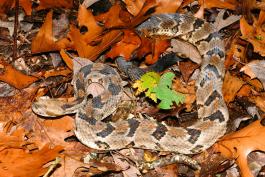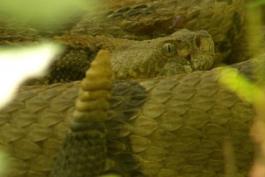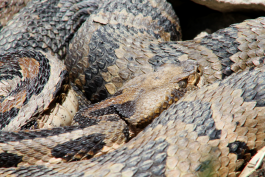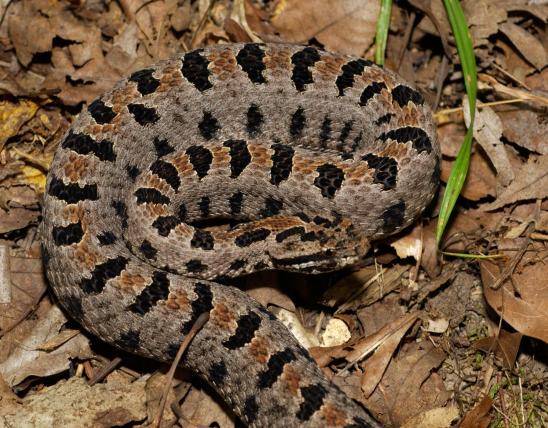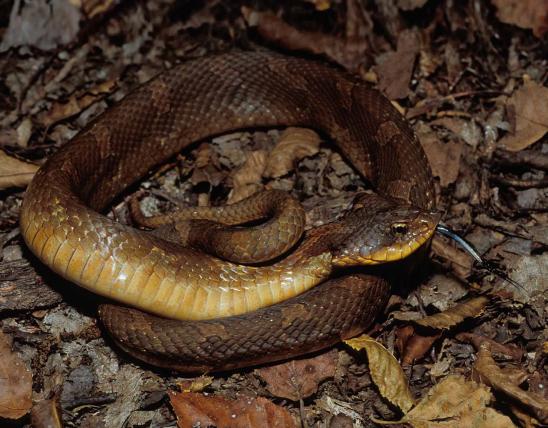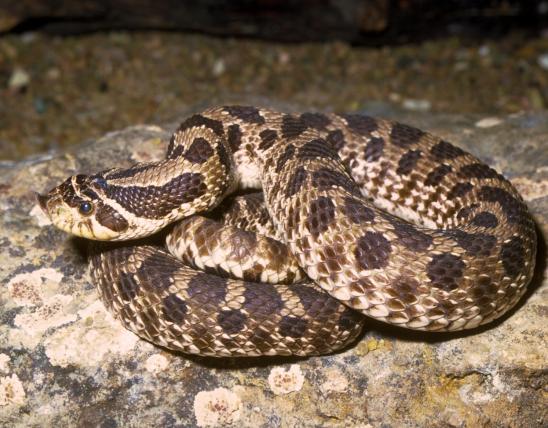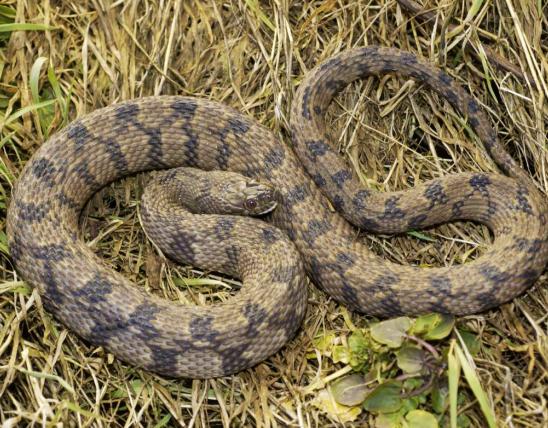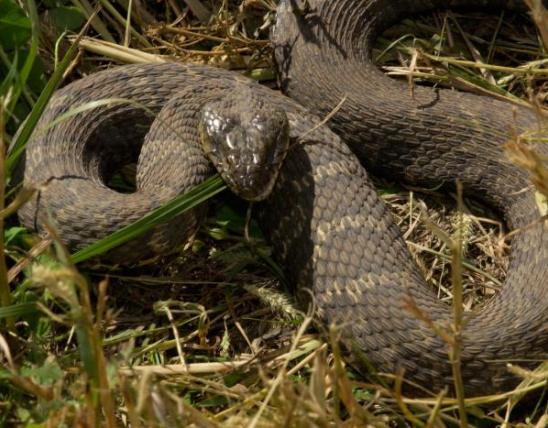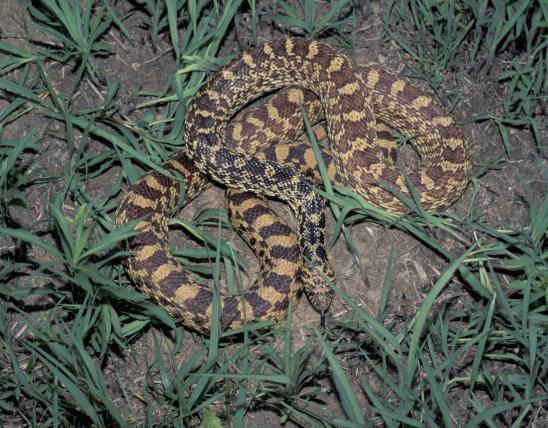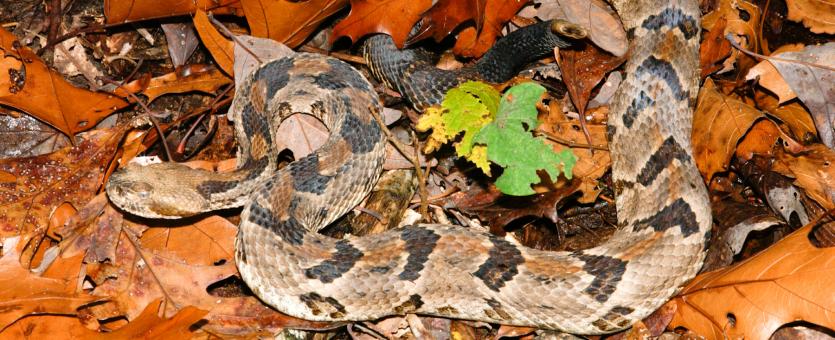
The timber rattlesnake is Missouri’s largest venomous snake. It is heavy bodied and has a prominent rattle at the end of its tail. Its ground color may be yellow, tan, brown, or gray, with dark brown markings. The head normally has a dark brown line from each eye to the angle of the jaw. Dark markings along the body are rounded at the front of the snake, changing to bands or V-shaped lines along the midbody to the tail. There usually is a rust-colored stripe running down the back. The tail is black and often described as “velvet-tailed.” The top of the head is gray, light tan, or yellow, and unmarked. There is a large sensory pit (heat-sensing pit) located between the nostril and eye on either side of the head. The belly is tan or light gray and sprinkled with small gray or brown specks. The scales along the back are keeled, and the anal plate is single. Most of the scales along the underside of the tail are in one row. The large rattle is straw colored. Young timber rattlesnakes are lighter in color than adults.
This snake, like many others, uses camouflage to avoid being seen; however, it will bite if harassed. It is dangerously venomous, and medical attention must be sought immediately if someone is bitten. There are only a few cases of rattlesnake bites in Missouri.
Rattlesnakes typically vibrate their tails, causing a sharp buzzing sound, when alarmed. Do not rely on a rattle sound for identification, though; remember that snakes’ tails are occasionally injured or cut off, and that a surprised snake may not have time to sound its rattle.
Similar species: The timber rattlesnake, found statewide, is our most widespread rattlesnake. Missouri has three other rattlesnakes known from within its borders, each with limited distributions:
- The western pygmy rattlesnake (Sistrurus miliarius streckeri), which does not exceed 20 inches in length, lives in counties bordering Arkansas and in the eastern Missouri Ozarks.
- The prairie massasauga (S. tergeminus tergeminus) is limited to the northwestern corner of the state and some north-central counties; it is state endangered.
- The eastern massasauga (S. catenatus) occurred along the Mississippi floodplain north from St. Louis; it has apparently been extirpated from our state.
Length: adults usually 36 to 60 inches (about 3–5 feet). They are known to reach up to 75 inches in length.
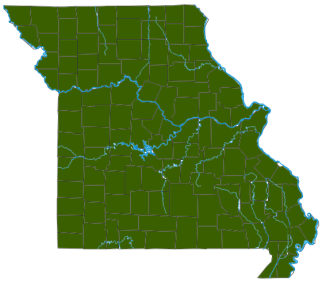
Formerly statewide, but now eliminated from a number of counties. Thus is it generally considered to be statewide, but with few records in the prairie regions in southwestern and northeastern corners, as well as the lowlands in southeastern Missouri. There are likely several locations where the species has been eliminated.
Habitat and Conservation
This species prefers a habitat of mature forests and heavily wooded, rocky, south- and southwest-facing hillsides near streams and rivers. In general, timber rattlesnakes may be associated with large areas of rugged, hilly, heavily forested terrain with ledges and bluffs. In the northern half of Missouri, there are rock ledges and river bluffs where this species and others (such as copperheads and western ratsnakes) congregate in overwintering dens. In the southern half of the state, where there are many suitable overwintering sites, denning in large numbers is less common. Inactive rock quarries are often used as overwintering sites, especially if natural sites are lacking.
During the active season, timber rattlesnakes spend a great deal of time coiled in a secure site such as near a fallen log or under a large flat rock. Inactive timber rattlesnakes are either lying in wait for a rodent to venture close or resting while a meal is digested. This species is known to climb trees and into bushes that are usually less than 16 feet high, presumably to seek prey or a safe place for shedding.
During spring and autumn, individuals bask in the sun on south-facing rock ledges and bluffs. They emerge from overwintering dens during periods of sunny weather and warm air temperatures, generally 75–80F. During the hot summer, this species becomes mostly crepuscular (active at dawn or dusk) or nocturnal.
Timber rattlesnakes are shy. If encountered, they may remain motionless to avoid detection, relying on their color to camouflage them among low bushes, branches, and dead leaves. Once disturbed, an individual may quickly move away and try to escape or coil in a defense posture and rattle.
Due to the rough country where this species normally occurs, and the fact that it is mostly nocturnal during the summer, few Missourians encounter this species.
Food
Timber rattlesnakes eat a variety of rodents (mice, rats, voles, shrews, and squirrels), small rabbits, and occasionally birds. They use their venom so that they can take their prey without a struggle. A secondary use for the venom is for self-defense.
Status
Habitat loss, persecution, and poaching have caused some localized decline of this species in our state.
The bite of a timber rattlesnake is dangerous and can cause human death. If bitten, seek medical attention immediately. Because this species normally occurs in rough country and is mostly nocturnal during the summer, few Missourians ever encounter it. There are few cases of people being bitten by this species in Missouri.
Life Cycle
Mainly active from April through mid-October. They bask on sunny rocks in spring and autumn. In summer they are mostly nocturnal. In Missouri, timber rattlesnakes begin courtship and mating mainly during the summer or early autumn, though, some mating as early as late April has been reported. Female timber rattlesnakes in Missouri produce a litter of young mainly every third year, but some individuals reproduce every two or four years. Litters average about 8 or 9 young. The young are born during August, September, and early October. The female stays with the young for 7 to 10 days prior to dispersing, and newborns are known to follow adult odor trails, including their mother, to find an overwintering site.
Timber rattlesnakes have been documented as living to 41 years of age in the wild, and a wild female was estimated to be at least 51 years of age.
Timber rattlesnakes are born with a single rattle segment on their tail and each time the skin is shed a new segment is added to the base of the rattle. A timber rattlesnake may shed three to five times during an active season. As the rattle becomes longer, the terminal segments tend to weaken and break off. Thus, counting the number of segments is not an accurate method for determining the age of a rattlesnake.
Human Connections
Venomous snakes play an important role in many human religions. Myths and folktales about snakes abound. The fear and curiosity that venomous animals inspire often lead us to look more closely at the natural world as a whole. Many naturalists, professional and amateur, got their start by learning about such awe-inspiring creatures.
Many of the animals that rattlesnakes eat (such as rodents and rabbits) are problematic for human interests such as food and grain storage, and agriculture. Many of us do not feel love for snakes, but we must appreciate the work they do that helps our economic interests.
Many people in Missouri mistakenly call the timber rattlesnake the diamond-backed (or diamondback) rattlesnake. That common name more correctly applies to other species that do not occur in Missouri.
Missouri's venomous snakes are dangerous to people and should be avoided. Even freshly killed specimens can inflict a dangerous bite due to reflex action. A local or regional American Red Cross office can furnish up-to-date information on venomous snakebite first aid. In the event of a snakebite caused by a venomous species, the victim should be transferred to a hospital emergency room as soon as possible. Most bites occur when people are trying to kill or handle venomous snakes.
Accidental bites can be avoided by staying away from areas where there may be a concentration of venomous snakes.
- Wear protective footwear in habitats where dangerous snakes may occur.
- Never place your hands under rocks or logs, and do not step over rocks or logs. Step on them first, then over.
- When walking in a forest, step lively.
- Look the ground over when you stop to stand or sit, particularly around large rocks or logs.
- Pit vipers are most active in late evening and at night; be extra careful during these times.
- Finally, avoid any snake you cannot identify.
Most species of venomous snakes are shy and normally avoid people. When encountered in the wild, they usually try to escape detection by remaining motionless. Often, an individual that is provoked will try to escape rather than defend itself. Once cornered, however, these snakes will do their best to defend themselves. Learning to distinguish venomous from nonvenomous species by their color and pattern is recommended.
Ecosystem Connections
As predators of rodents and small rabbits, rattlesnakes serve a vital role in controlling the populations of those prolific breeders. Yet they, too, fall prey to other predators such as hawks, owls, minks, skunks, and herons. Their young are especially vulnerable to predation.
Rattlesnakes are considered the most evolutionarily advanced group of snakes. The buzzing or rattling sound is a warning to potential predators or others who might otherwise molest this snake; this communication gives the snake and a potential enemy a chance to de-escalate a confrontation, so that biting need not occur.
A variety of insects or insect larvae (such as beetle larvae or camel crickets) may take advantage of a resting or sleeping rattlesnake and chew on a few segments of a rattlesnake's rattle — the rattles have no feeling.




